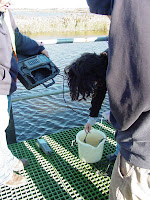Friday, November 30, 2007
The Benefits of Hart Miller Island
The Hart Miller Island has community, enviromental, and economical benefits. Community wise, it has beach, boardwalks, observation tower, and most of all wildlife observation oppertunity. Enviromental and economically the Island has had a substiantial role. The Island is a key place for wildlife sanctuary, which has attracted more than 280 types of species only in the south cell. It has also perserved, restored, and created an essential island habitat for willdlife; it also provides enviromental study oppertunities for those that are interested. Economically, it has kept uninterrupted operation for the Boltimore Harbor, which contributes more than three and half billion dollars to the region.
Heart Miller Island
Heart Miller Island was designed as a facility to process and place dredge material removed from the shipping channel of the Chesapeake Bay. The material is removed from the bottom of the bay and placed on barges. the barges transfer the material to Heart Miller Island where it is pumped using pressurized water to specific points on the island. DNR began this project in 1981 when Heart Island and Miller Island were connected with a sandy beach. At this time the dikes were built around the 1x2 mile area that is the island today. The dikes were raised to 28 feet in 1988 and then to 44 feet in 1997. The South Cell is approximately 290 acres and contains 16 million cubic yards of dredge material. Today this cell no longer receives dredge material and is currently a self sustaining habitat for many species. The North Cell is approximately 750 acres and has a capacity of100 million cubic yards.
Wednesday, November 28, 2007
Water Test Point 3
Recreational Area

 This is the are that was filled in with sand to connect Heart and Miller Islands. Water breaks were installed to prevent the tide from eroding the beach. The state park provides camping and recreation, as well as fishing and crabbing. If you have a boat you can come and enjoy the scenic views and relax. The observation tower is now useless since the dike wall were raised to 44 feet in 1997.
This is the are that was filled in with sand to connect Heart and Miller Islands. Water breaks were installed to prevent the tide from eroding the beach. The state park provides camping and recreation, as well as fishing and crabbing. If you have a boat you can come and enjoy the scenic views and relax. The observation tower is now useless since the dike wall were raised to 44 feet in 1997.
Water Test Point 2
The Transfer Station
the Development of Heart Miller Island
Water Test Point 1


The South Cell is home to over 280 species of birds that have been observed here since 1977. This is also the first test point of water quality. The water is tested for suspended solids, ph level, temperature, and salinity before it is released into the bay.
The red wing is a commonly seen bird at Heart Miller Island, the mud flats and pond water in the South Cell provide a habitat to many species of birds.
Reservoir
South Cell
The Boat Trip to Heart Miller Island
Subscribe to:
Comments (Atom)






















